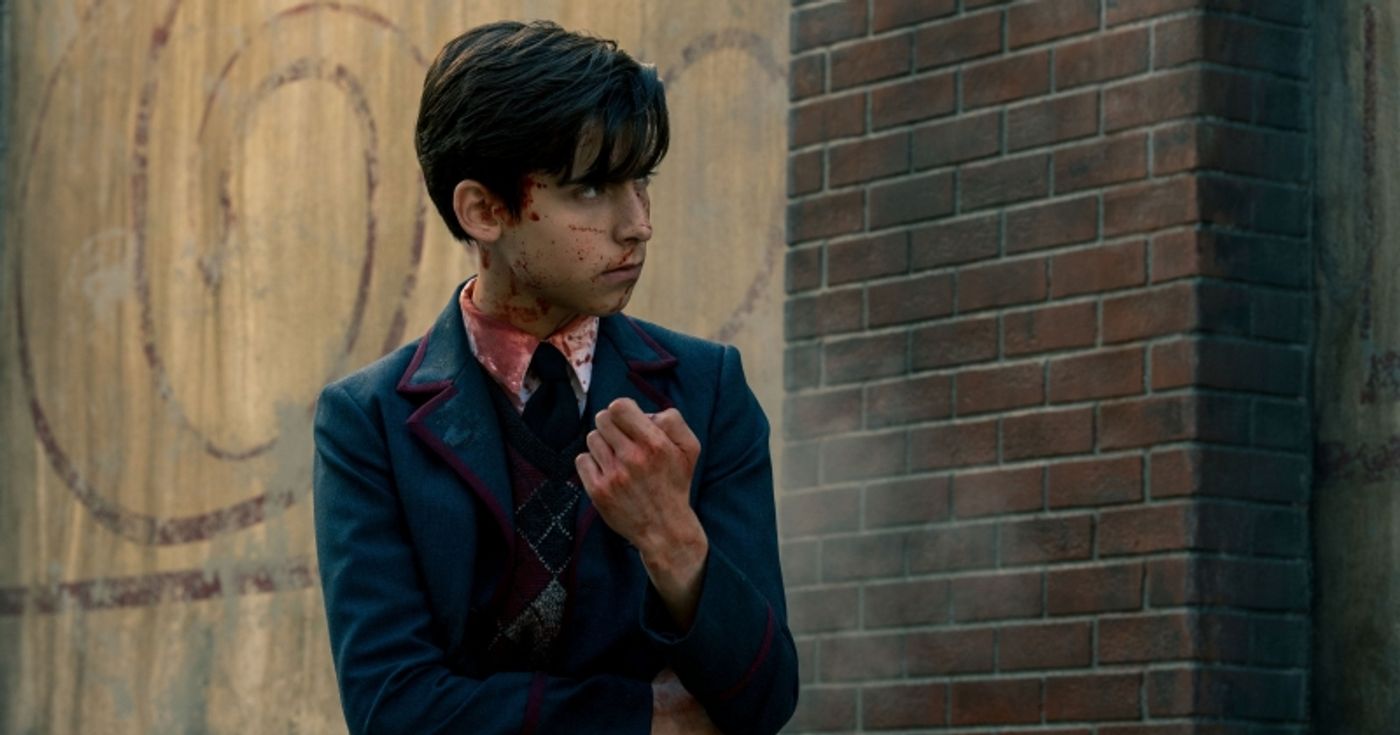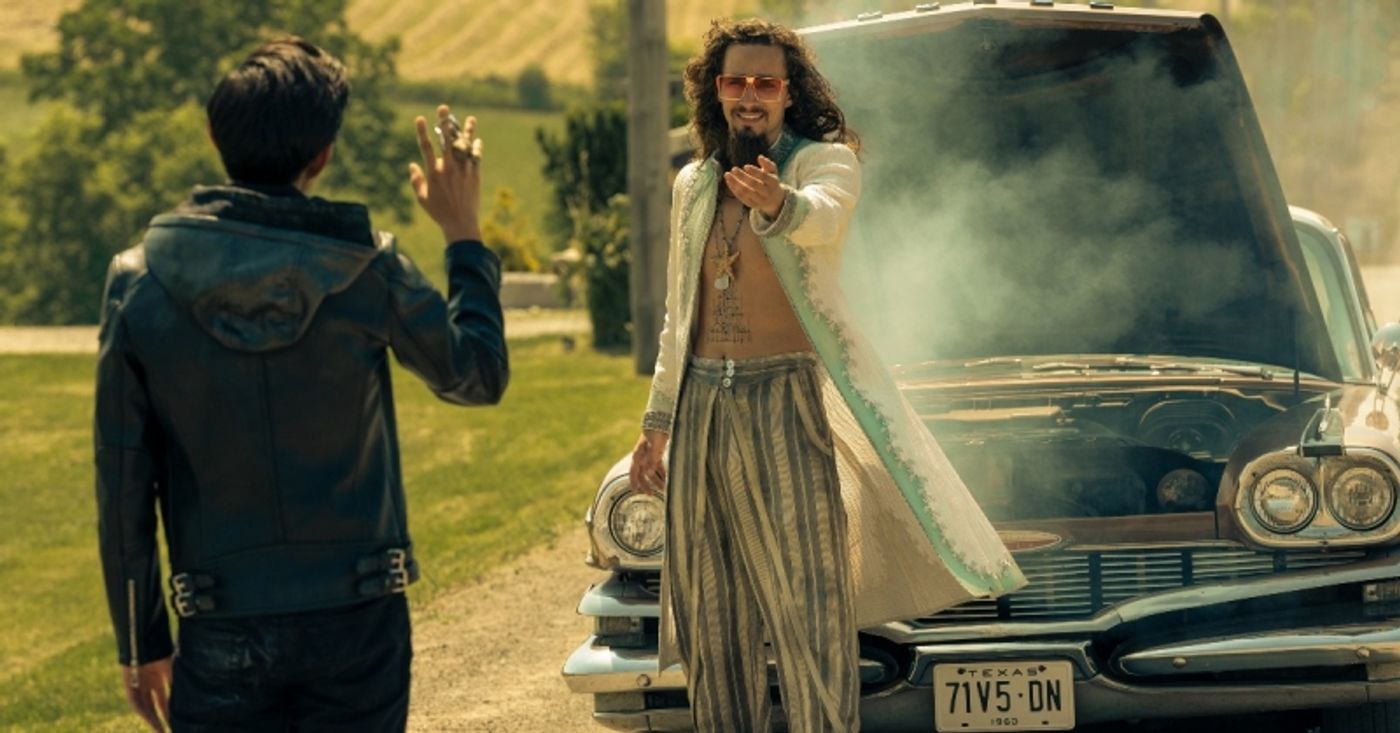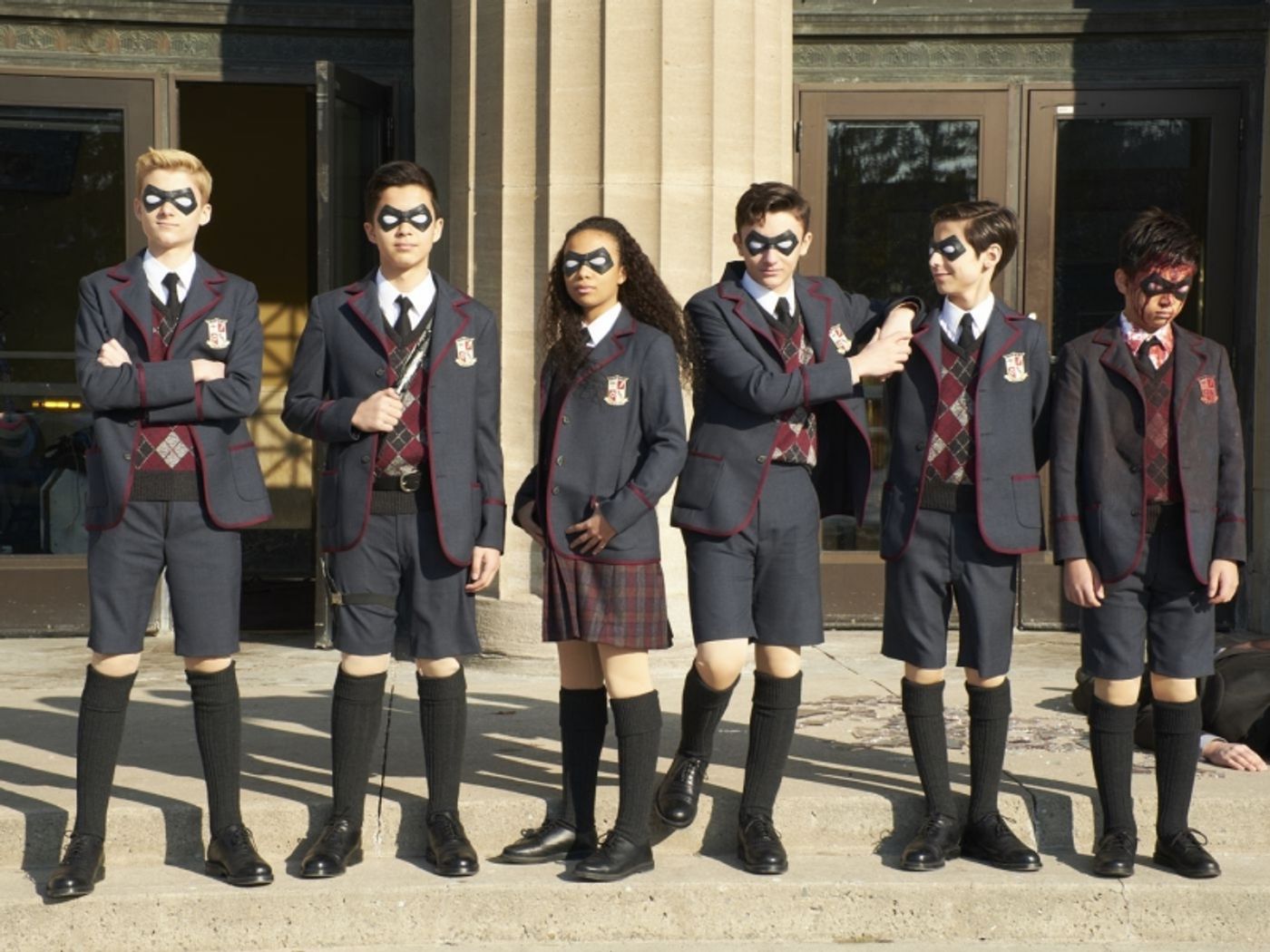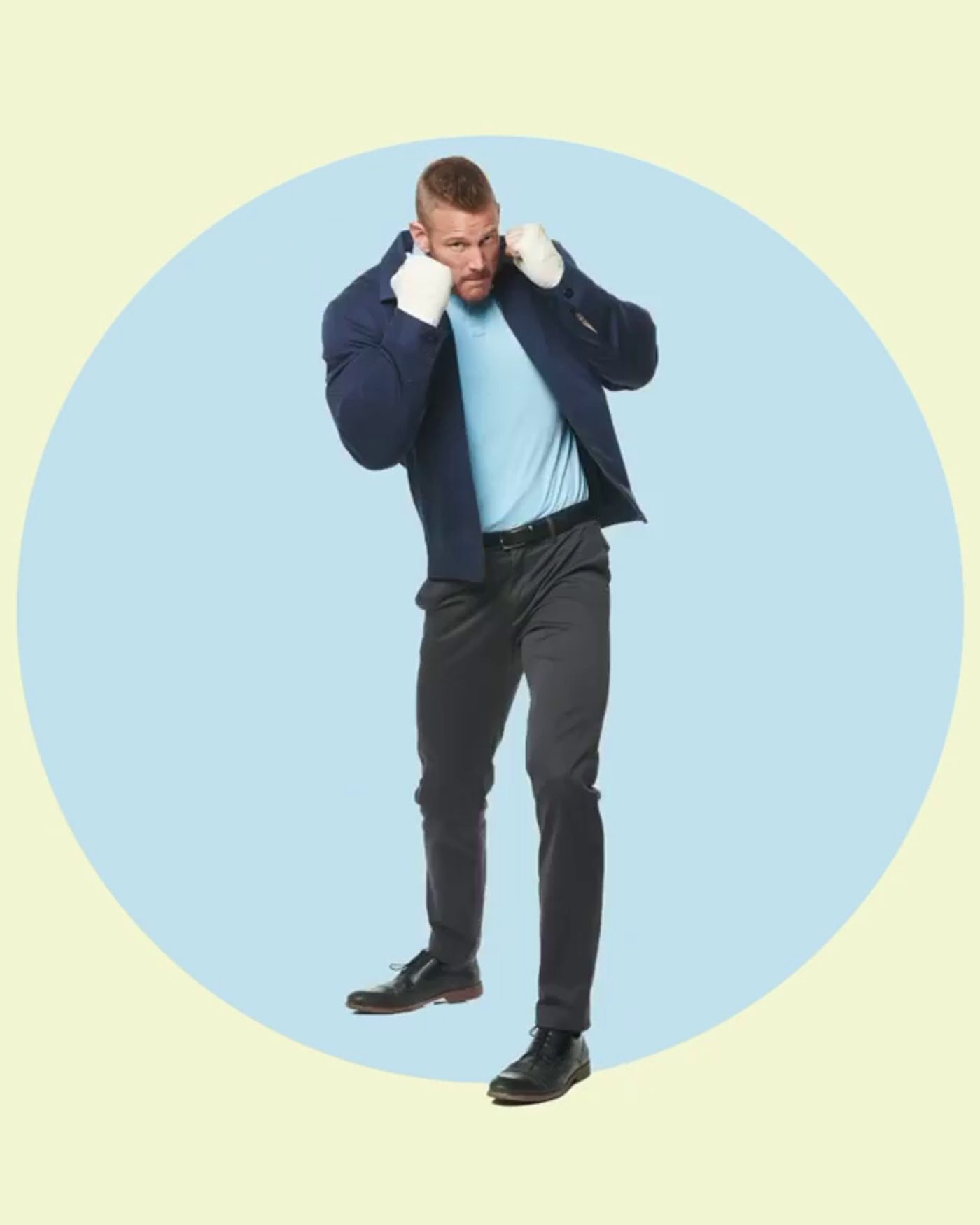Student Blog: An Interview with Emmy-Nominated Costume Designer Christopher Hargadon
Where we discuss muscle suits, blood and guts, and more!
.jpeg)
A couple of weeks ago, I had the opportunity to chat with Christopher Hargadon, a costume designer who has worked on TV shows like Hannibal and movies like Anon. He has just received a 2021 Emmy nomination for his work on The Umbrella Academy.
What is your favorite color?
Well, my immediate response was blue.
I love blue, it's really so pretty and has such variety.
It's also a very soothing color. But I love color theory. Sometimes the Costume [Designer] Guild will ask people [in interviews], "What can't you live without?", and for me, actually, it would be color.
When did you start getting into costume design?
Well, when I was a teenager - I grew up in the 70s and I'm tall, and they didn't actually build clothes specifically for tall men. So, when I wanted something specific, I would have to make it - otherwise the sleeves are too short, the pants are too short, that type of thing. So, anyhow, [I made clothes] without any knowledge whatsoever [except] my grandmother helping me a little bit in lending her sewing machine. I used to make patterns out of garbage bags, and I didn't know anything about grain line and they'd all twist in the wash. That's where I started actually being involved with clothing, but I never had any intention of ending up where I am now.
I actually loved travel and languages, so I trained [in] university as a translator. But that led me on travels, and eventually [into] a situation where I met someone who had a very large and successful design firm in France, [and] I ended up doing an apprenticeship there. And once that started, immediately I was having dreams of patterns - flat patterns molding themselves into three-dimensional shapes, and I felt like I was in the right place at that point. That was my early 20s.
Wow, that's a very cool path you took!
Well, my friends at that point had quite distinct career directions - they were much more traditional, and I came from a family of a lot of professionals, and they all went to law school and medical school, and I didn't know specifically what I would be interested in or good at. So it was serendipitous, because I was out there floating around. But when you're young and you're open, things happen, and you're in situations where you meet people. I always encourage young people to allow themselves that freedom, because sometimes things happen in environments that aren't your normal comfortable ones that lead to something really great.
When costuming for a show, especially one as bloody as The Umbrella Academy, how do you account for any fluids or other items ruining the costumes?
You read the scenes or the arc of the episode, and then you assess how many you need. Sometimes it's triplicates. With the leads on this show, often I have a dozen of each thing, which gets into heavy, heavy purchases or builds. We do a lot of building on this show, so when I'm buying fabric, I always account to have many multiples. This year was different, because we've been shooting all the episodes under COVID at the same time, which is something I've never experienced before. Often we would shoot two episodes, but we were shooting eight episodes at the same time, so we had more of an idea of the arc and what was going to happen to the characters, when they would change, how many costumes we'd have, so it gave me a pretty clear idea [of] what was going to be happening to the costumes. I mean, eventually, if they wear the stuff long enough, they all end up in the dumpster for quite a while.
That's really cool to hear, because I've always wondered how that's done!
Right now, there's one particularly serious injury, but the character plays that for a long time, so I said, "Do you want it to be seriously this gross for the entire scene, or shall I dial it back for the following scenes?" So what we're going to do is [have] the initial thing that happens, but then I'm going to reduce it for the costume multiples moving forward so that it's not not quite as aggressive on the eyes for the viewer, and also less distracting. We do all kinds of subliminal tricks with costumes that hopefully aren't particularly noticeable for the viewer, but that help support the storyline.

Things changed so much between Season 1 and Season 2 of this show - how did you create these 60's era looks while still infusing it with the characters' styles and personalities?
Well, everybody underwent some form of metamorphosis, [especially] because they were all arriving at different times, too, so they weren't a group. Allison, for instance - she went from being a celebrity and to being, initially, a sweeper at a hair salon. And then once she got her voice back, she had a much more active role in the protests. But the fact of the matter was, she was living in Dallas in the South in the early 60s, and [she and] her partner, Raymond Chestnut, live a modest, middle class, African-American existence, so her clothing was dramatically different from season one. And, something that was a wonderful discovery along the way was that Emmy, who plays the part of Allison, totally suited the 1960s. I had a lineup of vintage clothes, and she would just walk into all of them, which really was quite astounding. Normally with fittings, I do a lot of pinning and tweaking and shaping and remodeling, [and] I didn't have to do that. We did a lot of building for her as well.

Each character has some rather monumental shift - Klaus is supported by this wealthy benefactress and eventually becomes a cult leader. [Luther] is a bodyguard for Jack Ruby, and Number Five is Number Five, trying to solve problems as usual. Ben is still dead I guess, [so] he was consistent. [For] Diego, they really wanted him to have a Latin American flavor in the second season, so I tried to use warmer colors. And the first season I was riffing off the [graphic] novel, so he has a sort of black and blue striped sweater, and he was a sleuth/vigilante, but he was a little bit more vibrant in the second season. It's what keeps the show interesting for me, because nothing really [stays] static, and I think that's important when you're watching a series or you're involved in it - it has evolution that keeps you interested.

.jpg?format=auto&width=1400)
As a student of the arts, I love hearing about the collaborative process that goes on behind the scenes. What is that collaboration like?
Well, collaboration is obviously really important. I feel like, within costumes, we're in the middle of everything, because obviously the writing comes first and then whatever characterizations come out of it we have to get the feel of in order to represent visually.
[There's] always the discussion with the hair department as to the final and total look, because it's a visual medium where we're trying to show who this person is. We also really have to work closely with production design. I remember one time, years ago, on one of the faster, dirtier things that I was working on, there was an actress who played a mother who [was] having a family dinner, and there was a large group of people. I sent her off to set in a beautiful green blouse with a type of blue, lacy pattern overlay, and somebody called me from set and said "Maybe should come in and take a look at this.", and the pattern on the wallpaper was identical to her blouse in color and pattern. She looked like a floating head in the background. [That's an] example of not collaborating with production design. So I'm always wanting to know colors of vehicles or interiors of rooms. And you know, [with the] writers, we don't actually get a lot of contact, but the showrunner, who heads up the writers usually and is very much involved with them, is our doorway to all information, so the experience with the showrunner is paramount always. and on [the show], we just happen to have a brilliant [showrunner]: Steve Blackman. He is super enthusiastic, has a wonderful feeling for story, emotion, character, [and] development of art. Just couldn't ask for a better person to work with. It's a group effort, for sure. We're always collaborating; it's fun.
I noticed, as someone who has seen the show and read the comics, some of the costumes pull from the comics directly, while others step away from the source material - where did these decisions come up, and how did production inform that decision?
Well, I always want to refer to the original source as much as possible. And in this particular case, the original source was so inspiring and so visually captivating. I was very aware of that. And with Diego, and even [Sir Reginald] Hargreeves' color palette in the beginning of the season, I kept very much on the same lines as that of the graphic novels.
In the original graphic novels, I didn't find Vanya and Alison hugely different visually, so once the casting was done between Elliot Paige and Emmy Raver-Lampman, already they were so different. And you know, we had this direction to go with an androgynous look for Season One Vanya. Klaus was always dressed in black [in the novels], and Diego was blond, so the casting ended up informing my direction to a large degree. When we had Robert, it just kind of naturally evolved that he would be an eclectic, fun, kind of fluid character and drafts. I tried in Season One to keep a balance between men's clothes and women's clothes, because Rob can fit into lady's clothes just as easily as men's, he's a chameleon. But as we went down the line, I found that most of his clothes, if we don't build them, are lady's clothes, and they look good.
And the school uniform was a stark black and white - it was great in the novels, but when we actually camera tested it, it was a little too harsh. It almost was not feeling like part of the same scene, so that's where I looked to soften it a little bit by putting them into a blue-gray with a bit of a burgundy trim on the jacket, and that was probably one of the very first things I did when I came onto this show.

Luther Hargreeves is obviously heavily padded to emulate the strange proportions of the comic - how much of that padding work was given to you versus another department, and how did you work around that?
That's something we had to take in hand. In the comics themselves, Luther is massively disproportionate. He's got a tiny head and this huge, huge body, and he looks like wearing a diaper with tube capacitors. So obviously we weren't going to let Tom Hopper do that. And it was so sweet, because Tom showed up in amazing shape, and then we think he realized we were going to be putting this massive thing on top of his actual body. I hired a prosthetics company who specializes in this type of thing - we had him scanned, and then we had the body muscle suit build, which was underneath all of those costumes. It evolved over a couple of years - we found that the tummy area was too protrusive, and there was a lot of tabbing around the back, making kind of like a hunchback, so we took that down. When we went into the second season, we actually rebuilt all of the muscle suits, and reduced them significantly so [it] is actually more looking like somebody who could exist. We've had to design costumes around those parameters, where the neck would be high enough to cover the neckline of the muscle suit, and the sleeves are always long. You know, Tom was a great sport throughout - he's always been very sort of patient with the crazy things that he has to wear.

Stepping away from something like the Umbrella Academy, because I know that you've done work on a bunch of other different projects like Hannibal - what is the difference between costuming something that's more modern versus something more stylized?
Something like Hannibal, for instance, was modern day, but it was very character-based as well. Each player in that had a highly developed look under themselves, and it was very different from everyone else. Alana, until the third season when she started to really evolve out of who we knew into something more dominant and different, she wore these patterned wrap dresses, and that's not something that I would put on an actor on an ongoing basis, but the showrunner loved them and they were really appropriate, so that sort of became her trademark. And the checked suits with Hannibal - I was ready to put him in stripes and all kinds of different things, but Bryan Fuller who was my guide really, said "No, I just want to stay in check, I love the check". So I thank him for that, because it kind of became something that was notable about Mikkelsen's character - he always had this particular look until Season Three, when he went rogue and was wearing leather jackets and all kinds of stuff. Character dressing is another thing that is a lot of fun for a costume designer, because whether it's contemporary or period, there are subtleties involved [with] colors, textures, and silhouettes to distinguish them from the people around them. I always feel like my job is to highlight the actor and their face. I never want to detract from that with a distracting costume. So any costume that's really impactful is planned that way. Otherwise, I try to do it in a very subtle way. For instance, Will Graham in Hannibal, we did a lot of tweaking and fitting, but his costumes were really not supposed to be noticed. I was actually asked at one time specifically about his costume, and I really appreciated the question, because I never thought that anybody would actually notice the work that went into him.

Because the Handler wasn't in the comics, you had to start from scratch, versus the visual inspirations you received for other characters - I wondered, where did that inspiration and aesthetic come from?
I have a large collaboration with the actor. For me, I feel like my job is situated between the showrunner, director, and the actor. In the case of Kate, when she came on board, she's a person who really loved clothes, and she told me as a little girl she always dreamt of wearing these amazing costumes, and I'm not sure in her career if she ever really wore anything outlandish. So from the get go, we had a lot of fun, because my point of departure with the character is often the fabric of what I'm building. I'll go on a big fabric haul [in] New York, or LA, or up here in Toronto. With her [character], I pulled as many fabrics that had an impact or reached out to me as I could possibly find. I wanted her, everytime we saw her, to make an entrance; I wanted it to be something interesting and fun. She also oscillated between the 1950s and the 1960s, so she had two eras to work with. And then beyond that, when she took over The Commission, I dressed her in something that was mildly Napoleonic. I had a lot of fun playing around with it. So Kate came and saw the different fabrics, I had concepts of silhouettes already up on the board, and we looked at the silhouettes and then we looked at fabrics, and together we chose which fabrics we would apply to which silhouettes and then that would evolve from there. If it was 1950s, with a nipped waist and a full skirt, I would start from there and then I would decide exactly what the detailing would be. For me, building always starts with the fabrics, because I want the fabric to reflect the character as well. And with her, it was great because it was an array of colors and she's very exacting about the fit. We just had a great time working together.

Have you seen anybody recreate or cosplay your designs, and if so, what is your reaction?
Well, I actually had the opportunity to attend Comic Con in Paris - I think it was October 2019. I was doing some forums, and while I was up on the stage I [saw] a whole bunch of Handlers and Klauses and various characters in the audience, which I just thought was brilliant. And I have an Instagram which I basically dedicate to my work, and most of my posts are regarding [The Umbrella Academy], but I have a lot of people who reach out and they'll ask specific questions about construction, or where to source fabric. I'm always really blown away by the dedication and the effort. It was so upbeat and positive, and the people were so happy and friendly. I'm very honored when people like something that I've done enough to actually emulate it. It's quite a thrill, actually.
What is your favorite project that you've ever designed costumes for, and why?
Everything you do is with its own treasure, and I've worked with some wonderful people over time, both in front of the camera and behind the camera. I've got to say, the Umbrella Academy, it really is. It's so diverse and fun, and the audience is so diverse. I don't really recommend it for kids ten years old, necessarily, but you can start watching it when you're a young teenager, and I have friends who are in their sixties who watch this. I think it would have to be this one.
Christopher can be found on Instagram (christopherhargadondesign).
All photos belong to their respective owners.
Videos


